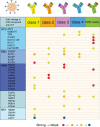Sub-lineages of the SARS-CoV-2 Omicron variants: Characteristics and prevention
- PMID: 35992968
- PMCID: PMC9380698
- DOI: 10.1002/mco2.172
Sub-lineages of the SARS-CoV-2 Omicron variants: Characteristics and prevention
Abstract
Since the start of the coronavirus disease 2019 (COVID-19) pandemic, new variants of severe acute respiratory syndrome coronavirus 2 (SARS‑CoV‑2) have emerged, accelerating the spread of the virus. Omicron was defined by the World Health Organization in November 2021 as the fifth "variant of concern" after Alpha, Beta, Gamma, and Delta. In recent months, Omicron has become the main epidemic strain. Studies have shown that Omicron carries more mutations than Alpha, Beta, Gamma, Delta, and wild-type, facilitating immune escape and accelerating its transmission. This review focuses on the Omicron variant's origin, transmission, main biological features, subvariants, mutations, immune escape, vaccination, and detection methods. We also discuss the appropriate preventive and therapeutic measures that should be taken to address the new challenges posed by the Omicron variant. This review is valuable to guide the surveillance, prevention, and development of vaccines and other therapies for Omicron variants. It is desirable to develop a more efficient vaccine against the Omicron variant and take more effective measures to constrain the spread of the epidemic and promote public health.
Keywords: Omicron variant; SARS‐CoV‐2; immune escape; neutralizing antibodies; vaccination.
© 2022 The Authors. MedComm published by Sichuan International Medical Exchange & Promotion Association (SCIMEA) and John Wiley & Sons Australia, Ltd.
Conflict of interest statement
The authors declare that they have no conflict of interest.
Figures



Similar articles
-
The emergence and epidemic characteristics of the highly mutated SARS-CoV-2 Omicron variant.J Med Virol. 2022 Jun;94(6):2376-2383. doi: 10.1002/jmv.27643. Epub 2022 Feb 11. J Med Virol. 2022. PMID: 35118687 Free PMC article. Review.
-
The rapid rise of SARS-CoV-2 Omicron subvariants with immune evasion properties: XBB.1.5 and BQ.1.1 subvariants.MedComm (2020). 2023 Mar 15;4(2):e239. doi: 10.1002/mco2.239. eCollection 2023 Apr. MedComm (2020). 2023. PMID: 36938325 Free PMC article.
-
SARS-CoV-2 Omicron Variant of Concern: Everything You Wanted to Know about Omicron but Were Afraid to Ask.Yonsei Med J. 2022 Nov;63(11):977-983. doi: 10.3349/ymj.2022.0383. Yonsei Med J. 2022. PMID: 36303305 Free PMC article. Review.
-
SARS-CoV-2 Omicron variant: Immune escape and vaccine development.MedComm (2020). 2022 Mar 16;3(1):e126. doi: 10.1002/mco2.126. eCollection 2022 Mar. MedComm (2020). 2022. PMID: 35317190 Free PMC article. Review.
-
A comprehensive review on Covid-19 Omicron (B.1.1.529) variant.Saudi J Biol Sci. 2022 Sep;29(9):103372. doi: 10.1016/j.sjbs.2022.103372. Epub 2022 Jul 15. Saudi J Biol Sci. 2022. PMID: 35855306 Free PMC article. Review.
Cited by
-
Long COVID: The latest manifestations, mechanisms, and potential therapeutic interventions.MedComm (2020). 2022 Dec 8;3(4):e196. doi: 10.1002/mco2.196. eCollection 2022 Dec. MedComm (2020). 2022. PMID: 36514781 Free PMC article. Review.
-
Immunological and metabolic characteristics of the Omicron variants infection.Signal Transduct Target Ther. 2023 Jan 21;8(1):42. doi: 10.1038/s41392-022-01265-8. Signal Transduct Target Ther. 2023. PMID: 36681668 Free PMC article.
-
COVID-19 in patients with anemia and haematological malignancies: risk factors, clinical guidelines, and emerging therapeutic approaches.Cell Commun Signal. 2024 Feb 15;22(1):126. doi: 10.1186/s12964-023-01316-9. Cell Commun Signal. 2024. PMID: 38360719 Free PMC article. Review.
-
XBB.1, BQ1.1 and atypical BA.4.6/XBB.1 recombinants predominate current SARS-CoV-2 Wavelets with flu-like symptoms in Cameroon: A snapshot from genomic surveillance.PLOS Glob Public Health. 2024 May 10;4(5):e0003153. doi: 10.1371/journal.pgph.0003153. eCollection 2024. PLOS Glob Public Health. 2024. PMID: 38728356 Free PMC article.
-
Comparative Computational Analysis of Spike Protein Structural Stability in SARS-CoV-2 Omicron Subvariants.Int J Mol Sci. 2023 Nov 8;24(22):16069. doi: 10.3390/ijms242216069. Int J Mol Sci. 2023. PMID: 38003257 Free PMC article.
References
-
- Wang Q, Guo Y, Iketani S, et al. SARS‐CoV‐2 Omicron BA.2.12.1, BA.4, and BA.5 subvariants evolved to extend antibody evasion. bioRxiv. 2022:2022.05.26.493517.
-
- Callaway E. Are COVID surges becoming more predictable?. Nature. 2022:605. New Omicron variants offer a hint. - PubMed
-
- Sidik SM. Had Omicron? You are unlikely to catch its rising variant. Nature. 2022. - PubMed
-
- Stegger M, Edslev SM, Sieber RN, et al. Occurrence and significance of Omicron BA.1 infection followed by BA.2 reinfection. medRxiv. February 19, 2022. 10.1101/2022.02.19.22271112. Published online. medRxiv. - DOI
Publication types
LinkOut - more resources
Full Text Sources
Miscellaneous
